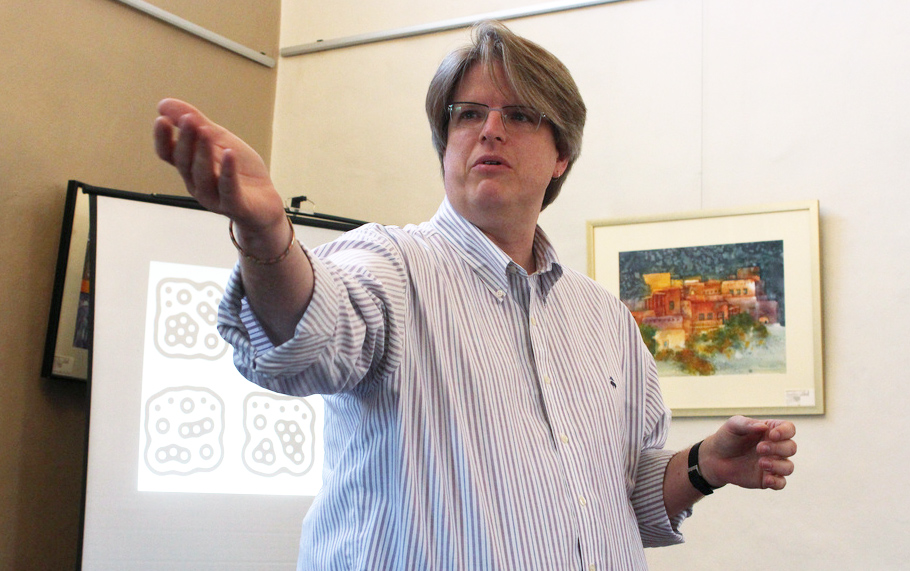Currently an independent consultant for museums, Bruce Wyman was originally a marine biologist. While working at the New England Aquarium, he helped build the museum’s first website in 1995. From that point on, he continued to focus on integrating technology with museums at the aquarium and later with the MIT-connected startup NearLife, Second Story, the Denver Art Museum and multiple other institutions.
We spoke with Wyman about the role technology should play in a museum exhibition, how museum professionals should think about the web, and why museums should think of themselves as publishers.
Technology Is Not Always the Right Answer
In 1997, the New England Aquarium invested funds for a new interactive element for their fiddler crab exhibit. Fiddler crabs have one small claw and one very large claw, the latter of which they use to communicate with each other. Wyman and his team built a robotic prototype, controllable by visitors, that would wave at the other crabs. In contrast, another museum staffer found that by using a paper clip and a piece of paper, the same outcome could be obtained. One cost tens of thousands of dollars, the other about 10 cents.
The takeaway was that experience itself is what excited visitors, not the technology. The visitor experience has to be smooth, seamless and magical, in Wyman’s words. If it isn’t, don’t do it. In a blog post referenced in the interview below, Wyman wrote:
“Frankly, visitors frequently don’t care about the technology and I agree with them. Give them something rewarding, some meaty bit of fun and engagement and concentrate on designing what that experience could and should be. Once you get a good sense of that, the technology begins to fall into place and you stumble across new kinds of experiences that have the power to delight the visitor and probably more efficiently serve your original goals.”
Instead of chasing the newest and flashiest technology, museums should focus on what story the visitor remembers. In the example above, it would be “How fiddler crabs communicate.” Technology can offer many ways toward achieving that goal, but should by no means be considered a requirement.
Online Exhibitions Should Be Integrated From the Point of Inception
If a museum is working on an exhibit for their physical site, and then asks how it can be retrofitted from the web, then the visitor experience is already going to be lacking. Just as Wyman described the need for museums to collaborate from the beginning on implementing technology, the same should hold true for the web.
Institutions should look at the types of content they have, whether it is artwork, scientific insight or historic objects. With a content-first strategy, museums will focus primarily on what they do best, and then consider which segment of that content fits best with which platforms. Some stories are best told in the traditional exhibit presentation, others in on-site interactives, others on the web and even others on a tablet or smart phone app.
When the National Museum of Natural History opened up their new human evolution exhibit in 2010, they also built a Meanderthal app that gave visitors (virtual or in person) to take a photo and alter it to see what their face would look like as an early human. Here was an instance of excellent integration between content and medium.
At the Denver Art Museum, an exhibit on 1960s protest posters gave visitors their own space to create posters of their own using stencils and the like. Elsewhere in the exhibit, Wyman and his team retrofitted an old rotary pay phone to play YouTube videos of old ’60s songs, but with the added feature of allowing visitors to record their own messages on the phone. These videos were immediately uploaded to YouTube and became a part of the online exhibition.
Museums as Publishers
Publishing should be seen as a broad over-arching term in the new media environment. Museums “publish” content when they open a new exhibit or when they post their collections online; it is more than just pressing “pubish” on a museum blog. Online exhibitions are a version of publishing all on their own, where it can exist as “long tail” content and reach 10 times as many visitors as a brick-and-mortar exhibition can. As long as a museum has a high tolerance for publishing boatloads of new content, it should continue to do so as the data has long since borne out that the more museums share, the more visitors are encouraged to come to the physical space.
Museums Should Look to Startup Culture As a Guide for Using Technology
Wyman joined the staff of the Denver Art Museum in 2004 coming from the NearLife startup and found a lot of lessons from there that could be applied to museum culture. Startups try multiple small projects and take chances, but by assuming that every project would eventually be seen by the public, the quality remained high and the museum’s mission was always at the forefront. The other key takeaway was the importance of collaboration, that each branch of a museum staff have to understand each other’s goals and motivations.
Once everyone on staff shares the same goal of telling great stories to their audiences, then the methods of how to get there can be opened for discussion.
Listen to the interview
Listen to the streaming audio above or download the mp3 file.
